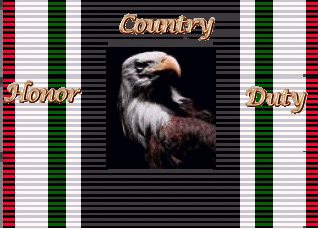|
 |
|
|
 |
|
 |
 |
 |
Thanks to Joni's Patriotic Graphics. |
This
Page Is Dedicated To
|
|
|
| Thanks to Joni's Patriotic Graphics. |
|
| Source: Compiled by Homecoming II Project 31 April 1990 from one or more of the following: raw data from U.S. Government agency sources, correspondence with POW/MIA families, published sources, interviews. |
| REMARKS: |
| SYNOPSIS: All tactical strike aircraft operating in Southeast Asia had to be under the control of a Forward Air Control (FAC), who was familiar with the locale and the tactical situation. The FAC would find the target, order up U.S. fighter/bombers from an airborne command and control center or ground based station, mark the target, and control the operation throughout the time the planes remained on station. After the fighters had departed, the FAC stayed over the target to make a bomb damage assessment (BDA). The traditional FAC needed a fighter pilot's mentality, but was obliged to fly slow and low in such unarmed and vulnerable aircraft as the Cessna O1 Bird Dog, and the Cessna O2. |
| Another type
forward air control was called the "Misty" FAC. Misty operations were flown high
and fast in such aircraft as the F100, able to cover a larger area than the small,
traditional aircraft flown by the "hands-on" FACs. Their role, although not
usually directly in the arena of ground fire, was hazardous. The enemy had weapons to
reach them, even at their greater altitude. The North American F100 "Super Sabre" first saw action in Southeast Asia in northwest Laos in May 1962. F100 operations in Vietnam began in 1965, and took part in Operation Flaming Dart, the first U.S. Air Force strike against North Vietnam in February of that year. Further deployments of the aircraft to the area left just five F100 squadrons in the United States. Various modifications were made to the aircraft affectionately called "Hun" or "Lead Sled" by its pilots and mechanics over the early years, gradually improving night bombing capability, firing systems and target-marking systems. Maj. Michael O. McElhanon and Maj. John F. Overlock were pilots assigned to the 309th Tactical Fighter Squadron at Phu Cat, South Vietnam. The missions they generally flew were Misty FAC operations over North Vietnam. McElhanon was rated as a pilot and Overlock as a co-pilot. On August 16, 1968, McElhanon and Overlock were on an early mission and had already refueled once (the maximum range for the F100 is nearly 1500 miles), and had radioed the Airborne Control that they were enroute to rendezvous with a tanker over the Gulf of Tonkin for the second refueling. That was the last contact Airborne Control had with Overlock and McElhanon. They were not missed until some fifty minutes later, when a flight of fighter aircraft tried to locate them to get a fix on their target. The plane is assumed to have gone down somewhere near the city of Dong Hoi in North Vietnam's Quang Binh province. No one knows for sure what happened to Overlock and McElhanon. If they went down close to the city, they could have been captured. If they went down over the Gulf, they may never be found. For the next 5 years, their families waited to see if McElhanon and Overlock had been captured. When 591 prisoners were released in the spring of 1973, the two were not among them. Experts said that there were hundreds who were expected to be released and who were not. Finally, in late 1975, the U.S. Government declared the men dead, based on no specific information that they were alive. Were it not for the thousands of reports received that Americans are still held captive, the McElhanon and Overlock families might be able to assume they died and go on with their lives. But as long as men are alive, Overlock and McElhanon could be among them. It's time we brought our men home. Michael O. McElhanon was promoted to the rank of Colonel and John F. Overlock was promoted to the rank of Lieutenant Colonel during the period they were maintained missing. |
Please go back to
the main page and write your letters.
|
| Thanks to Ron Fleischer. |
| "All Biographical and loss information on POWs provided by Operation Just Cause have been supplied by Chuck and Mary Schantag of POWNET. Please check with POWNET regularly for updates." |
![]()
You can make a difference
too!
![]()
Sign
My Guestbook ![]() View
My Guestbook
View
My Guestbook
This page has been visited times. Since October 26, 1998.
This page last updated on April 17, 2000